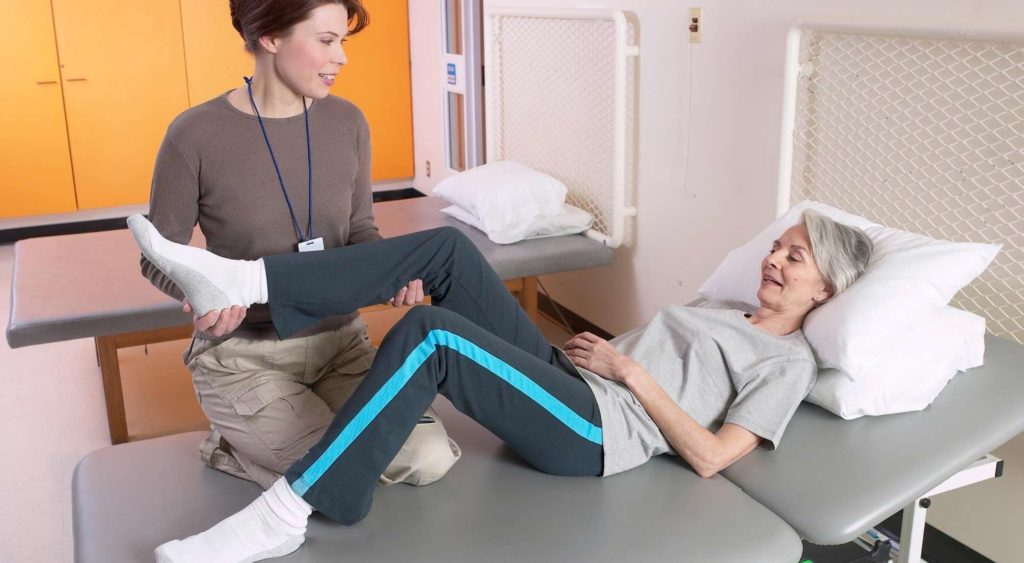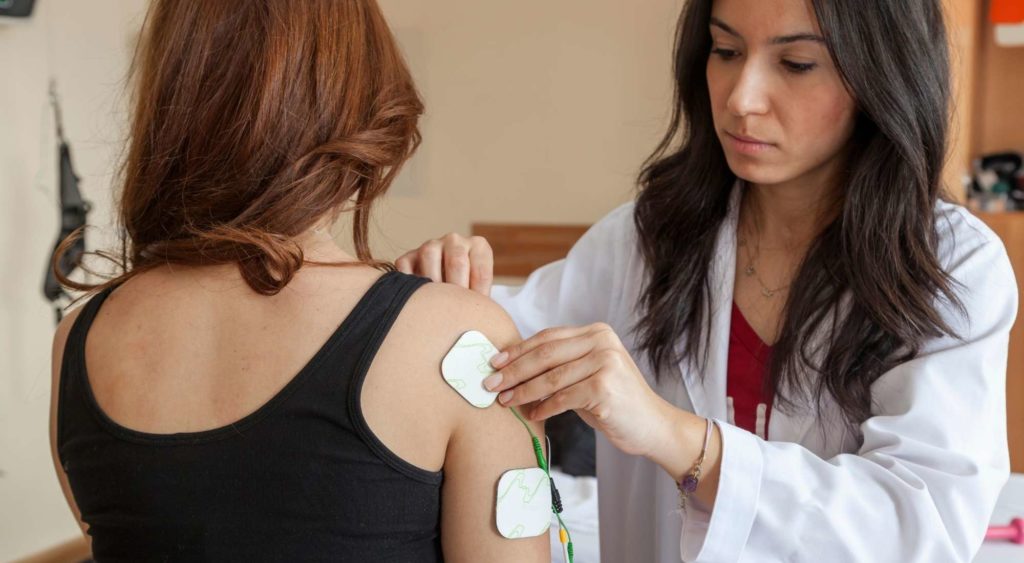
It can be overwhelming to go to physical therapy for the first time.
But it’s even more daunting to imagine living with chronic pain or recovering from surgery or an injury on our own. It can be hard on our bodies and our psyche.
How can physical therapy help with this?
In this guide, we will walk you through what to expect from physical therapy, and how it can help you heal and prevent further injury.
Table of Contents
- What Exactly Does a Physical Therapist Do?
- 3 Things You Can Expect to See in Your Treatment Plan
- What Does a Typical Physical Therapy Session Look Like?
- How Long is a Physical Therapy Session?
- How Long Does it Take For Physical Therapy to Work?
- 3 Ways Physical Therapy Can Make a Difference
- What to Expect at In Motion O.C.

What Exactly Does a Physical Therapist Do?
A Physical Therapist’s primary role is to improve or maintain your mobility and basic function, and manage pain.
This starts with doing an assessment.
Your physical therapist will ask you lots of questions, so it’s best to come prepared with your medical history and detailed information about your condition.
They diagnose problems of function and movements in your body through:
- Observation
- Measurement
- Reviewing medical history
- Listening to your concerns and symptoms
Your physical therapist might want to evaluate:
- Flexibility
- Range of motion
- Balance
- Coordination
- Blood pressure
- Gait (how you walk)
- Functional activities like rising from and sitting in a chair or car
Physical therapy is a fluid process — not a one and done. Evaluation is ongoing, and adjustments are made to your treatment throughout each appointment.
Doctors of Physical Therapy use a variety of techniques to help you reach your goals, and this all starts with a treatment plan.
Your Physical Therapist, sometimes called a PT or physiotherapist, creates your treatment plan. Physical therapist assistants and aides help carry it out. Along with your physical therapist, they’ll often be the ones to guide you through your exercises.
3 Things You Can Expect to See in Your Treatment Plan
In a treatment plan, you can expect to see a range of activities for you to do with the help of a physical therapist in the office, and at home.
These activities are going to address three main areas:
- Maintenance of your health
- Quality of life
- Workability and fitness
A treatment plan might also include coordinating information from your healthcare providers and a home care team. If family and caregiver roles need to be defined this will be included.
Your goals are important, so measurement is important to your progress. Means of tracking your progress will be outlined within your treatment plan.
You might be wondering, what does this mean for me?
Is physical therapy worth it? Keep reading to find out what you can expect from physical therapy and what a physical therapist can do for you.
#1 Education
Often times we lose all hope of feeling better because we don’t know how to eliminate pain on our own. You may wonder if it is even possible to feel better.
Debilitating pain doesn’t have to be a lifelong sentence. Improving your situation often begins with knowing what’s wrong.
Through education, your physical therapist will help you understand:
- What your body is going through
- Where you can go from here
- What it will take to get better
They help you learn about your condition and how to treat it. Sometimes these conditions may come back. They want you to be prepared and know how to handle it.
You can absolutely come back to your physical therapist after your treatment plan is completed. But they want to prepare you with the knowledge of how to treat it so you don’t have to.
They will educate you on proper exercise form so you don’t accidentally injure yourself at the physical therapy office or at home. This helps build your confidence to begin moving again.
With physical therapy, your pain won’t own your body anymore. You will. You’ll be armed with the knowledge of:
- How your body moves
- How to exercise properly to regain function and mobility; and
- How to prevent injury
#2 Exercise
Exercises are a great way to build strength in the affected area.
During your assessment, your physical therapist will outline the exercises you will do in the office with their guidance and exercises you can do at home. They’ll make sure to educate you on proper form before you leave.
They want you to feel confident in these exercises so you can safely do them yourself. They may also give you aids such as exercise bands to continue your regimen at home.
Remember to wear comfortable clothing that gives the physical therapist access to the affected part of your body. Your physical therapist may need to see how your body moves, or physically manipulate that part of your body, so clear access to the area is helpful.

#3 Therapeutic Modalities
Therapeutic modalities are techniques to carry out the treatment plan. These techniques are designed to help you gain strength, comfort, and mobility.
These are some typical therapeutic modalities you might see in a treatment plan:
- Ice
- Heat
- Ultrasound
- Acupressure
- Acupuncture
- Electric stimulation therapy or TENS (transcutaneous electrical neuromuscular stimulation)
- Iontophoresis
- Exercise therapy and techniques
- Musculoskeletal manipulations
- Joint mobilization
- Massage
- Kinesiology taping
- Hydrotherapy
What Does a Typical Physical Therapy Session Look Like?
Your first physical therapy session is unique. Assessment and many conversations need to happen before the work can begin. The treatment plan is established, appointments have been made. Now it’s now time to work on improving or maintaining your movement.
Where physical therapy takes place also matters.
In addition to their own clinics, physical therapists are needed in:
- Hospitals
- Nursing homes
- Rehabilitation facilities
- Outpatient or at-home services
Care may begin at one facility and be transferred to another smoothly.
How Long is a Physical Therapy Session?
The typical length of a physical therapy session is around one hour.
Let’s look at an example.
John came to a physical therapist for ankle pain. His doctors are unsure without extensive testing what exactly is causing this pain, but the physical therapist is confident they can help him regain some normal function.
The first appointment is dedicated to assessment, education, and developing John’streatment plan. After that, each appointment is dedicated to carrying out that treatment plan.
One hour allows enough time for:
- A warm-up – such as 10 minutes on a stationary bicycle
- A conversation about John’s symptoms and experiences after doing his exercises at-home
- A recap of John’s progress, or reevaluation of techniques if they’re no longer improving his condition
- Therapeutic modalities such as writing the ABCs with his ankle, gentle resistance exercise with a band, and balance work.
- Ankle massage by the physical therapist or physical therapist assistant
- Ice and electric stimulation therapy
Progress is recorded throughout the treatment process and a partnership is developed between John and his physical therapist. John is responsible for continuing his care at home, and the PT is responsible for maintaining his treatment and continued evaluation of his progress.
How Long Does it Take For Physical Therapy to Work?
Depending on the goal and the individual, physical therapy can progress quickly or slowly.
The length of time it takes to reach that goal depends on factors such as:
- Age
- Diet
- Physical activity level
- Current medications
- Posture
- Pre-existing conditions that might impede progress
- The severity of the injury
- Your commitment to your recovery and the process
Expectation management is an important factor in the education your physical therapist will provide. A quality physical therapist will have an honest conversation with you about what you can expect from your sessions over time.

3 Ways Physical Therapy Can Make a Difference
Physical therapy is customized to your body and condition. It can prevent or treat conditions that make daily life functions a struggle.
Sometimes you can get in a rut and you don’t know how to reach your goals on your own. Chronic pain affects more than our bodies. It saps our motivation and joy.
Physical therapy is one means of recovering from that chronic pain.
#1: Recover From an Injury or Surgical Procedure
Physical therapy can help strengthen muscles, improve mobility, and reduce pain caused by injuries. After surgery, your body might need some guidance on how to heal well to allow you to resume your normal, everyday activities.
Your physical therapist will help you:
- Regain range of motion
- Reduce scar tissue
- Manage your pain levels throughout your recovery
- Strengthen your muscles
- Teach you how to do daily activities like getting in and out of a car, bathing, and walking
It can even help you avoid surgery altogether. Rather than invasive surgery, a PT may be able to help your body heal on its own.
Many medical doctors are recommending physical therapy before surgery.
For example, research shows that for the elderly needing cardiovascular surgery physical therapy before surgery, centered around exercise, reduced their hospital stay, and the risk for complications.
#2: Prevent Future Injuries
Let’s look at John’s case again. During his time with the physical therapist, he will be educated on proper form and exercises that will continue to strengthen his ankle. This will bolster the area, protecting it against further injury.
Another patient, Janelle, has been exercising for years. During a run, her knee twisted painfully and the “walk it off” method wasn’t showing improvement.
Through physical therapy, she was able to learn techniques to correct her movements, preventing her from injuring herself again.
Janelle will be coached during her exercises to learn proper form and will be taught how to strengthen her knee at home.
#3 Provides Education
Everyone heals at their own pace. Throughout the physical therapy process, you’ll learn the limits and potential of your own body.
Your physical therapist can help you prevent re-injury by giving you the tools to treat it.
You’ll gain the confidence and independence to treat yourself at home. If you feel uncomfortable doing this on your own, you can always make a physical therapy appointment.
What to Expect at In Motion O.C.
Excellence! Our mission is to bring hope, healing, and confidence to others. We are experts in musculoskeletal issues. We provide an environment that is welcoming and built to provide you the most benefit.
Our physical therapists are highly trained and licensed with specialties in a range of topics.



